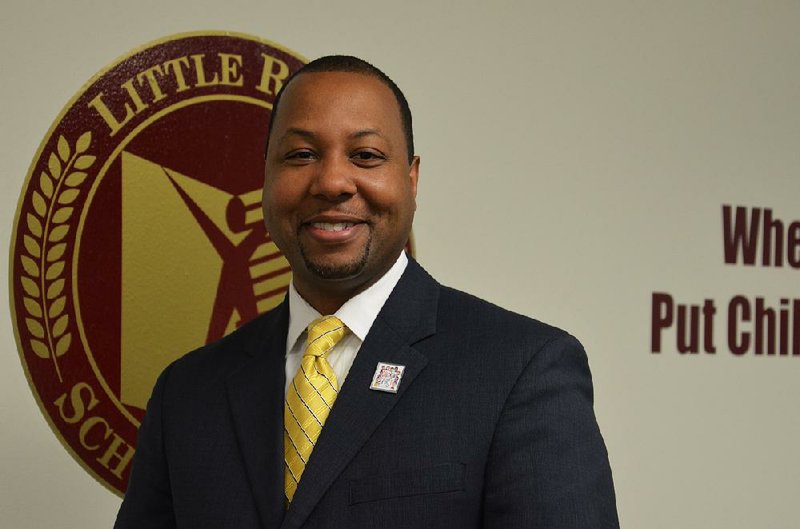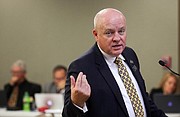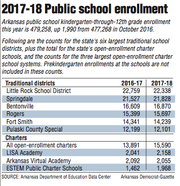The Little Rock School District has recorded an enrollment drop of more than 400 students in kindergarten through 12th grade for the second consecutive year, contributing to a loss of more than 1,000 students since 2014-15.
The capital city district, under state control without a locally elected school board and the home to a growing number of independently operated public charter schools, remains the state's largest school system this year by a 510-student margin over the Springdale School District in Northwest Arkansas.
The Little Rock district's count from kindergarten through 12th grade is 22,338.
That is 421 fewer than last year's count of 22,759, which was 405 fewer than the 23,164 student enrollment recorded in 2015-16. This year's number is 1,025 fewer than the 23,363 Little Rock district enrollment recorded in 2014-15.
The enrollment counts come as two new independently operated charter schools are state-approved to open in the Little Rock district's boundaries in the 2018-19 school year and a third is approved for opening in the 2019-20 school year.
District leaders in the past have argued against several charter schools in Pulaski County, saying they draw more affluent, high-achieving students and leave the traditional school system with higher percentages of students with great educational needs but with fewer state dollars to educate them.
More recently, Little Rock Superintendent Mike Poore argued against the three newest charters, saying there is already a surplus of elementary seats in most parts of the city.
The annual October enrollment count for Little Rock and all other Arkansas school systems, including charter schools, is considered the official enrollment for the year and a harbinger of state funding levels for the next school year. State funding for a district is based on the average kindergarten-12th grade enrollment in the first three quarters of the preceding school year.
A 421-student loss over the course of this school year could cost the Little Rock district about $1.1 million in state foundation aid in the 2018-19 school year, Kelsey Bailey, the district's chief financial officer, estimated Friday.
State foundation aid is money school districts and charter schools can use for general operations, including the payment of salaries and utility bills. The Little Rock district, which is projecting expenditures of $355 million this school year, is receiving about $2,634 per student from the state.
(The Little Rock district also serves pre-kindergarten pupils, which boosts the system's total enrollment to 24,182 for this year. But pre-kindergarten students are not part of the calculation of state foundation aid for a district in the same way kindergarten-12th grade enrollment is used.)
"It will impact us somewhat. Of course, we're constantly monitoring our budget and still looking for efficiencies," Bailey said about the ways to offset the loss of foundation aid.
Those strategies can include reducing teacher numbers at the elementary level and looking at course offerings at the secondary level, he said. He added that stipends, teacher-student ratios and administrative positions are always under scrutiny.
"We want to make sure we aren't too aggressive with our revenue numbers and make sure our expenses are maintained," Bailey said.
Poore routinely reports in his speeches to city groups that the district has made $42 million in cuts over three years, including $11 million for this year that entailed closing three campuses and converting a fourth -- an elementary school -- into an alternative learning center for secondary students.
Earlier this week, Poore said he is delaying decisions on possible employee pay raises or bonuses for this school year until early 2018. That delay is meant to give district leaders a better sense of available revenue and student enrollment projections for next year, based on student registration that is to take place next month for the 2018-19 school year.
The Springdale School District is the state's second-largest district this year with 21,828 in kindergarten through 12th grade, according to the data reported by all school districts to the state Department of Education.
Springdale is the largest of several large systems in Northwest Arkansas. The Bentonville district is the state's third-largest with 16,870 reported for this year. Rogers has a count of 15,697, and the Fort Smith School District's enrollment is 14,239.
In central Arkansas, besides Little Rock, the largest districts are the Pulaski County Special School District, which has 12,101 students this year, down from 12,199 last year. The Cabot district reported 10,472 in kindergarten-12th grade, up from 10,290. The Conway district's count is 10,001, up from 9,920. The Bryant School District has an enrollment of 9,121, down from 9,134, according to the state report, and North Little Rock's count is at 8,427, up from 8,405 last year.
The Jacksonville/North Pulaski district's enrollment is reported to be 4,306, compared with last year's 3,927. However, Bryan Duffie, the Jacksonville/North Pulaski superintendent, said Friday that the state-reported number for the district includes students who are no longer in the district and, as a result, is not accurate.
Duffie said the district's kindergarten-12th grade enrollment is 3,875, which is lower than last year's count. However, the district for the first time is serving 300 pre-kindergartners, putting the district over the 4,000 mark when the littlest pupils are included.
Elsewhere in the state, the Jonesboro district's enrollment is reported to be 6,209. The Pine Bluff district is at 3,648, and West Memphis is at 5,458.
Statewide, public school kindergarten-12th grade enrollment is up by 1,990 from 477,268 last year to 479,258 this year, according to the Arkansas Department of Education's Data Center, which is accessible to the public from the agency's website: arkansased.gov.
Included in that overall state total is the 15,590 enrollment for the state's 25 open-enrollment charter schools. That is up from 13,891 a year ago.
Additionally, the state has 1,053 schools this year and 238 traditional school districts. There are 33,203 certified teachers, 9,461 other certified staff and 29,426 classified staff.
In regard to the Little Rock district's enrollment declines, the state data show that the numbers of both black and white students have declined in the district since October 2016 and from 10 years ago, in the 2007-08 school year. However, the numbers of students who are Hispanic, Asian-American or two or more races have increased since last year and since the 2007-08 school year.
The Little Rock district's black enrollment went from 17,715 in 2007, to 14,603 in 2016, and to 14,040 this year. That is a loss of 563 black students since last year and 3,675 since 2007.
The district's white enrollment was 5,773 in 2007, 4,054 last year, and 3,971 this year. That's a decrease of 83 since last year and 1,802 since 2007.
The Hispanic enrollment was 1,733 in 2007, 3,183 in 2016 and 3,350 this year. Students of Asian heritage increased from 436 in 2007 to 563 last year and 595 this year. Students of two or more races total 318 this year. Students of Pacific Island and Native American ethnicity total 64 this year.
The district has historically lost middle and high school students to schools outside the district, starting after pupils complete the fourth and fifth grades.
The district's elementary school enrollment -- including pre-kindergarten pupils -- this year is 12,920, down 13 pupils from 12,933 last year. The high school enrollment this year is 11,128, down 357 from 11,485 last year. That is counting the Forest Heights STEM Academy's kindergarten-eighth-grade enrollment as a secondary school.
It also includes the expansion at Pinnacle View Middle School that went from sixth grade last year to sixth and seventh grades this year, from 222 students to 515 students.
Frederick Fields, the Little Rock School District's senior director of student services, took advantage of the district's conversion this school year to the state-required student data management system to track where fifth- graders in Little Rock district schools last year now attend sixth grade.
Fields' data show that of the 1,820 fifth-graders last year, 1,476 are currently enrolled in the district. There were 148 who enrolled in other Arkansas public schools -- either charter or traditional schools -- two who moved into home schools and seven who moved to private schools. The data do not specify a number for the different types of schools -- traditional or charter.
Additionally, he said, there were 16 who are known to have moved out of state but an additional 171 who are no longer in the district and are not in state databases, making it likely that they left the state without officially withdrawing from the Little Rock district.
The Office for Education Policy at the University of Arkansas, Fayetteville last year did a study of enrollment patterns among the traditional, charter, and private schools in Pulaski County using data from the 2008-09 through 2013-14 school years.
The study findings showed that some 10,000 students transferred between traditional public schools and charter schools in Pulaski County in that six-year period, but it also showed that greater percentages of students leave the Little Rock district in a given year for other traditional districts or for out-of-state and private schools than for charter schools.
A Section on 11/04/2017



